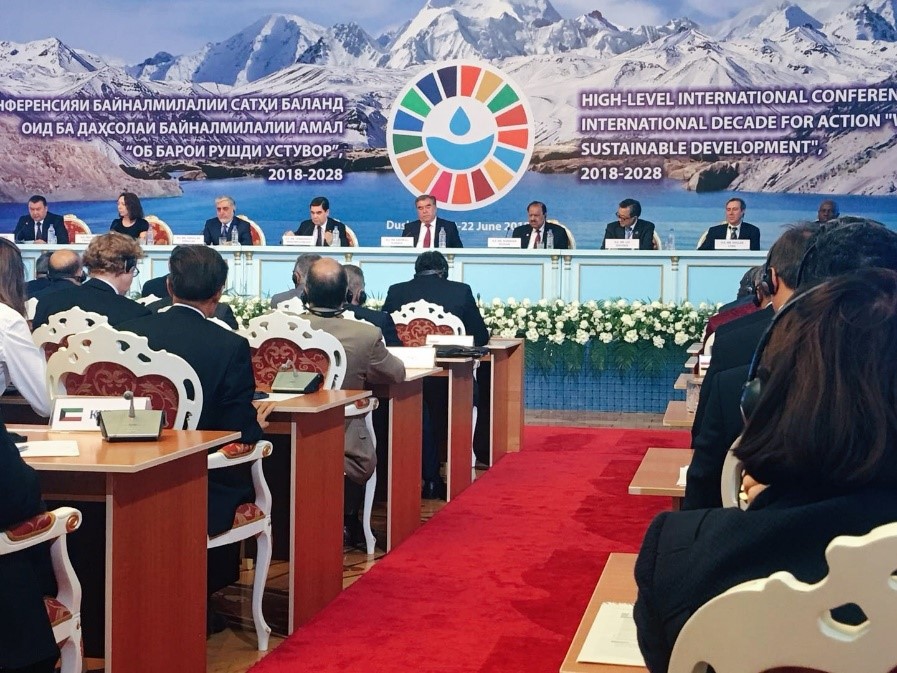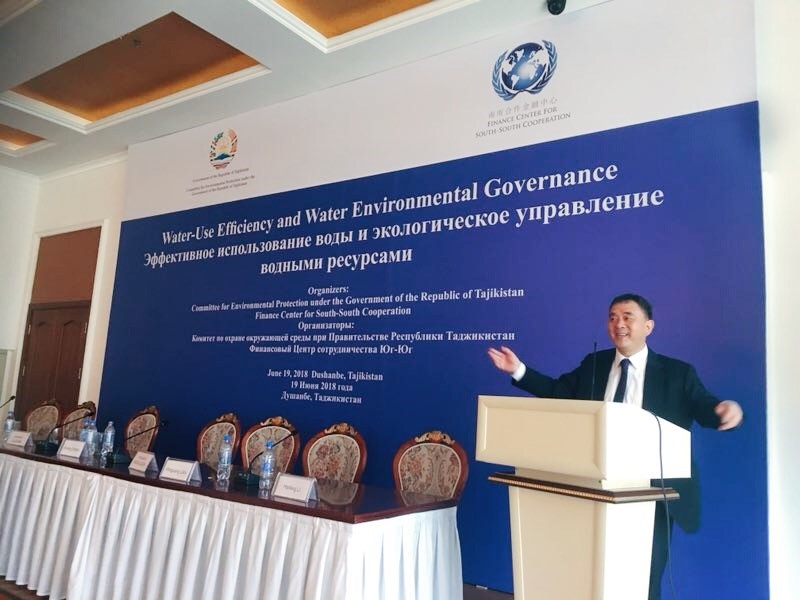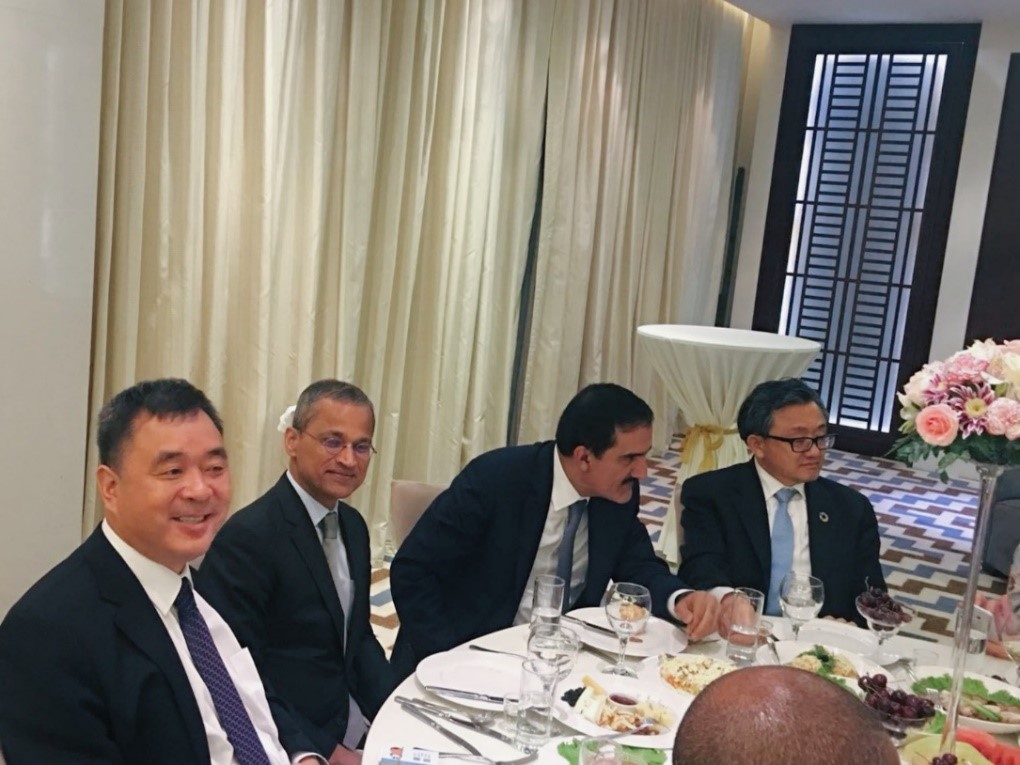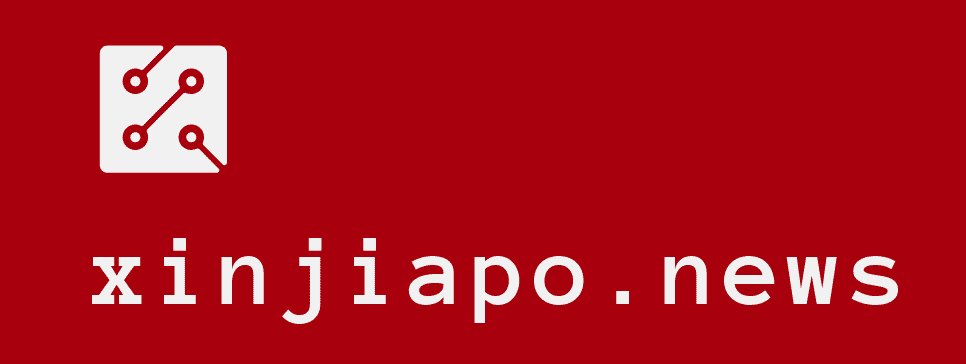蓝伟光教授出席联合国“可持续发展水资源大会 2018-2028”并发表演讲

当下,国际社会尤其是发展中国家,面临着缺乏安全饮用水、基本卫生条件堪忧、水资源缺乏、水污染严重等挑战。为了解决这些相互关联的问题,2016 年 12 月 21日,联合国大会通过了71/222项决议,宣布2018-2028为“水促进可持续发展国际行动十年”。
针对上述目标,为了调动各国政府、联合国机构、国际和非政府组织等机构的积极性, 2018年6月19-22 日,联合国与塔吉克斯坦共和国政府在塔吉克斯坦首都杜尚别共同主办了“可持续发展水资源大会 2018-2028”高级别国际会议。

联合国水资源大会开幕式现场一瞥
 蓝伟光教授在联合国水资源大会会场入口处
蓝伟光教授在联合国水资源大会会场入口处
本次大会聚焦与水相关的可持续发展目标,关注内容包括如何调动财政资源帮助水资源项目的有效推行,加强水资源的合理利用和管理能力,解决清洁饮水和卫生设施,以及现代科技与创新在其中的应用等多个领域。塔吉克斯坦总统拉赫蒙率其内阁总理、多位内阁部长出席了这一高级别的水资源十年行动计划国际会议,巴基斯坦总统候赛因及邻近多个国家的内阁总理、副总理,联合国副秘书长刘振民及多国驻联合国大使与高级官员、国际及地域组织、商界领袖、学者、教育家、非政府组织官员、河流湖泊盆地组织,以及妇女儿童与青年组织等1000多位嘉宾从世界各地来到杜尚别,出席了此次会议。
厦门大学水科技与政策研究中心首席科学家、新加坡中国科技促进与交流协会常务副会长、中国膜工业协会副理事长蓝伟光教授受作为演讲嘉宾受邀出席了这一高级别的会议,并在塔吉克斯坦政府与南南合作金融中心主办的“水资源利用和水环境治理”论坛上作了题为“Applying innovative technologies to improve water quality and increase water supply across the world”的主题演讲,受到了联合国高层官员、塔吉克斯坦共和国政府部长以及其他许多参会代表的高度评价与充分肯定。
 蓝伟光教授与南南合作金融中心主席蔡鄂生摄于会议论坛
蓝伟光教授与南南合作金融中心主席蔡鄂生摄于会议论坛
蓝伟光教授在演讲中就科技改善水质的问题阐述了他的观点,他认为应用创新的技术确保饮水安全与增加水的供给,既有技术的可行性,也有投资的经济性。蓝教授以他所领导的团队创新开发的两项技术“nanopurification (纳滤净化)” 与“membrane box (三达膜箱)” 的具体应用为例说明,无论是饮用水安全还是水资源短缺问题,都可以用创新的科技手段来加以解决。
 蓝伟光教授向塔吉克斯坦环境保护部的官员介绍三达纳滤芯技术
蓝伟光教授向塔吉克斯坦环境保护部的官员介绍三达纳滤芯技术
蓝伟光教授在演讲中还指出,今天人类面临的水危机,归根结底,可以总结为“水资源短缺、水污染严重、水分布不均”三大水问题。但应用现代的科技,不管什么样的水都可以变成所需要的水。因此,只要借鉴推广新加坡的经验,重新定义水资源、应用科技净化水、循环利用再生水,前述三大水问题都可以迎刃而解。进一步地,蓝伟光教授提出了“截污减排、分散处理、按需净化、分质用水、源头控制、终端把关”的二十四字净水方略,引起了参会代表的高度兴趣与广泛关注。
 蓝伟光教授现场接受塔吉克斯坦国家电视台的采访
蓝伟光教授现场接受塔吉克斯坦国家电视台的采访
蓝伟光教授在演讲中重申了他多年来一直坚持的与众不同的观点:世界不缺水与水处理的技术,缺的是水循环的意识与水利用的政策。他希望联合国可以利用其独特的平台与管道,科普正确的水知识、唤醒公众的水意识,呼吁公共的水政策。如此,各国政府就可以依靠应用已经开发成功的水技术,不但解决其面临的水问题(保护绿水青山),而且还可以创造一个新兴的水工业(成就金山银山)。蓝伟光教授认为,上述理念是对中国国家主席习近平确立的“绿水青山就是金山银山”生态文明思想的最佳诠释。

正在演讲中的蓝伟光教授
演讲的最后,蓝伟光教授基于塔基克斯坦共和国的水资源状况,为承办这一高级别水资源会议的东道主提供了“Given Tajikistan’s abundant freshwater resources, I suggest that they develop their water industry by applying innovative technologies such as nanopurification and membrane box”的建议,由此吸引了塔基克斯坦方面的浓厚兴趣。由此,塔吉克斯坦的国家电视台还专门采访了蓝伟光教授。
随附蓝伟光教授的演讲文稿如下:
Applying innovative technologies to improve water quality and increase water supply across the world
One of the most pressing and ubiquitous problem facing people across the world is the ever-growing demand for clean water. While much attention has been given to the protection and redistribution of existing clean water resources, emerging threats are forcing us to reassess what should be considered clean water resources in the first place. In a similar fashion, innovative technologies are challenging us to reevaluate the potential value of unconventional water resources such as wastewater.
Traditional methods based on the protection and redistribution of clean water resources require significant upfront capital investment to build out infrastructure and develop expertise. All in return for a technically imperfect solution that is unable to remove all potentially toxic micro-pollutants. A solution that is also impractical in developing regions due to the high financial, operational and energy costs associated; costs that restrict its application even in developed nations.
Fortunately, we have seen some countries successfully apply innovative technologies to recycle wastewater as well as improve the quality of drinking water; therebyaddressing the issues of water safety and shortage. Singapore is such an example. Firstly, all tap water plants are equipped with membrane systems designed to improve water quality. Secondly, taking an approach that collects and makes full use of every drop of water, Singapore has established its “Four National Taps”. The “Four National Taps” includes three new sources of water (rainfall stored in catchments and reservoirs, high-quality reclaimed water or NEWater, and desalinated water) in addition to imported water from Malaysia. As of 2016, the three new taps together provide more than 65% of the total demand for water in Singapore. This number is expected to reach 100% in 2060.
As a policy researcher in the water sector, I have personally observed a trend towards developing less energy intensive, more economic, more environmentally friendly and more user-friendly technologies. One example is nanopurification, an innovative water purification technology based on the integration of membrane filtration and active carbon adsorption, which can efficiently retain natural minerals while removing harmful contaminants. Nanopurification requires only regular tap pressure to generate adequate water flux and neither require electricity nor produce wastewater. In contrast, reverse osmosis technology which is widely adopted in water purification requires electricity to operate and produces wastewater as a byproduct. Therefore, in comparison to existing water treatment technologies such as reverse osmosis, the newly developed nanopurification is a more suitable option for developing countries.
A second example of innovative water technology is what I call “membrane box”. The “membrane box” is an integrated smart membrane bioreactor (MBR) system built into a shipping container. The key advantages of the “membrane box” includes lower investment, smaller physical footprint, easier installation and maintenance, enhanced effects of biological treatment, and higher quality of reclaimed water. This is a prime example of decentralized treatment technology that can be applied to under-developed regions and areas with low population density and/or insufficient financial capacity for large infrastructure projects.
I am proud to say that it was our research team that invented the two aforementioned technologies. As an acknowledgement of our efforts, we have received a series of invention patents as well as various awards from the Chinese Government.
While I have only given two examples, technologies of this nature have potential in both developed and developing countries. With technology, we can redefine the term “water resources” – producing abundant quantities clean water by tapping into previously unfeasible sources, including municipal and industrial wastewater, seawater, and brackish water. This new definition leads to new ideas in water production and management.
First and foremost, we should control pollution by reducing emission and discharge. With the increasing impact of manmade products and activities on nature, the quantity and types of harmful matters that are abandoned after use and discharged into the environment and water sources have risen dramatically. This situation requires that we remove all harmful matters, especially micro-chemical pollutants, in the water before it is being used.
Current technologies have the capability to clean up these water sources to meet our different needs at a lower cost.The key is to choose the technology that best fits local conditions. Local conditions include, but are not limited to, the main source of the pollution, the concentration level of these pollutants, and the intended use of the reclaimed water. To better address these local conditions, we recommend decentralized solutions such as the “membrane box” to control pollution and reduce emission and discharge, while recycling used water to increase water supply as well as recover by-products such as valuable metals and chemicals used in industry.
Second, when producing or purifying water, we should tailor the process according to actual demand. While under-purification may result in unsafe drinking water; over-purification results in a waste of money and resources that should be avoided as well. For instance, nitrogen and phosphorus are necessary nutrients for plants, but are considered contaminants in water meant for consumption. This suggests that applying drinking water standards, which requires the removal of nutrients for plants such as nitrogen and phosphorus, to irrigation water is neither economical nor optimal. Therefore, the method of purification chosen should fit the actual use of the water. This calls for the setup of multiple safety standards for water in different use cases.
Third, we should ensure drinking and cooking water is both safe and healthy. For example, pure or distilled water would not meet this requirement as they may be safe but definitely not healthy. The report Calcium and Magnesium in Drinking-water published through the WHO has articulated that, based on available evidence, many people in most countries do not obtain sufficient intakes of magnesium and/or calcium from their diets due to various reasons, and that mineral-rich drinking-water may provide substantial contributions to total intakes of these nutrients. In short, safe and healthy drinking water refers to weakly alkaline water within which microbial and chemical hazards have been removed while natural minerals already existing in the water have been retained.
While we should rightfully demand that water meant for consumption to be of the highest quality, the total volume actually required for consumption is relatively small – making up only about 2% of total water demand. If we overhaul current tap water plants to produce water that meets the aforementioned standards and rebuild pipeline networks to avoid secondary pollution, it would be both costly and wasteful. Alternatively, we could adopt purification technologies at the point of use (purifiers on taps) to dramatically reduce the costs. However, it is worth mentioning that the technologies selected should not only remove pollutants but also retain minerals that are beneficial to human health.
As a scientist, I do not worry about the readiness of appropriate technologies but would call for more supportive policies and wider public awareness to ensure that these ideas can be put into action. I believe the UN to be a powerful educational platform that can effectively disseminate knowledge about the capabilities of newly available innovative technologies, spread awareness about the state and nature of our water resources, and engage governments at all levels to adopt policies that support the growth and application of these technologies. I believe, together with wider public awareness and more supportive government policies, these innovative technologies will better solve the water crisis by improving water quality and increasing the water supply. Additionally, a new global industry in water, health and environment that is beneficial to human society would emerge as a result.
Tajikistan is a Central Asian country rich in freshwater resources. It has plenty of rainfall within its territory and a large number of glaciers and lakes with abundant freshwater in its mountainous regions. Its freshwater resources account for more than 60% of Central Asia’s, and it ranks the 8th and the 1st in the world in terms of the total freshwater reservation and the per capita freshwater reservation respectively. However, the water resources of the Tajikistan have not been used optimally and have yet to become a driving force of its economic and societal development. Due to the limited farmland, outdated irrigation facilities and highly water-consuming crops such as cotton and rice, the water used for agriculture has not generated optimal economic returns. Due to an underdeveloped water infrastructure, the problem of sanitary and safe drinking water for urban and rural residents has been unresolved for a long time.
Given the economically under-developed status and the urgent needs of Tajikistan, I would offer three suggestions at this point of time.
First, to secure the quality of drinking water for the benefit of public health with the least cost financially and easiest implementation technically, I suggest that nanopurificationtechnology at the point of use be adopted as soon as possible.Second, to implement a plan to upgrade Tajikistan’s water production and distribution systems. The guiding principle of the plan should be a decentralized system leveraging innovative technologies such as the “membrane box”; so as to avoid expensive capital investments into infrastructure.Third, to develop a water industry based on products such as bottled water that combines the advantages of innovativetechnologies as well as Tajikistan’s superior freshwater resources.In doing so, the rich water resources in Tajikistan can be turned into a powerful force to drive a positive change in Tajikistan’s economic, societal and environmental spheres.
 蓝伟光教授受邀参加的塔吉克斯总统Rahmon举办的欢迎晚宴现场一瞥
蓝伟光教授受邀参加的塔吉克斯总统Rahmon举办的欢迎晚宴现场一瞥
 蓝伟光受邀参加联合国秘书长刘振民举行的欢迎晚宴,上图从右到左分别为:联合国副秘书长刘振民、塔吉克斯坦驻联合国大使Mahmadamin Mahmadaminov, 新加坡驻联合国大使Burhan Cafoor, 蓝伟光教授
蓝伟光受邀参加联合国秘书长刘振民举行的欢迎晚宴,上图从右到左分别为:联合国副秘书长刘振民、塔吉克斯坦驻联合国大使Mahmadamin Mahmadaminov, 新加坡驻联合国大使Burhan Cafoor, 蓝伟光教授


















评论